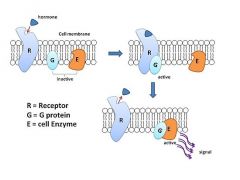![]()
![]()
![]()
Use LEFT and RIGHT arrow keys to navigate between flashcards;
Use UP and DOWN arrow keys to flip the card;
H to show hint;
A reads text to speech;
26 Cards in this Set
- Front
- Back
|
Transduction Pathway |
converts signals on a cells surface into cellular responses |
|
|
Quorum sensing |
The concentration of signaling molecules |
|
|
Biofilms |
Coordinating bacteria |
|
|
Paracrine Signaling (Description and example) |
Local signaling like that of bacteria |
|
|
Synaptic signaling (Description and example) |
Local signaling of nerve cells (one sends one receives) |
|
|
Hormonal signaling (Description and example) |
Long distance via bloodstream (adrenaline) |
|
|
Reception |
receives signal of receptor (Ligand normally on membrane) |
|
|
Transduction |
relay signal inside of cell (relay and amplify) (Kinases and phosphotases) |
|
|
Response |
Carry out an action |
|
|
GPCR |
-The largest family of cell surface receptor
|
|

Explain |
1. Ligand binds to GPCR 2. GPCR undergoes a conformational change 3. Alpha subunit exchanges gdp for gtp 4.Alpha subunit dissociates and regulates target proteins 5. Target protein relays signal via 2nd messenger (GTP then hydrolized (loses a phosphate) to gdp) |
|
|
receptor tyrosine kinase |
Triggers multiple signal transductions at once |
|
|
RTK vs GPCR? |
ATP vs GDP/ Dimers vs no dimers |
|
|
Receptor tyrosin kinase transduction pathways |
1. Signaling molecule (ligand) attatches to cell binding site. 2. conformational change ; monomers make a unphosphorylated dimer 3. Tyrosine gets atp and phosporylates turning atp to adp 4. inactive relay proteins attatch and phoshpates cause conformational change in relay proteins
|
|
|
ligand ion channel receptor |
act as gates for ions;membranes close when signal absent |
|
|
intracellular receptros |
stop the flow of ions |
|
|
kinases |
on switch; proteins to atp |
|
|
phosphatases |
removes atp from protein; stops reaction |
|
|
secondary messenger( cAMP & Ca2+) |
cells release secondary messenger molecules in response to exposure from extracellular signals |
|
|
scaffolding proteins |
to bring in close proximity |
|
|
Nuclear vs. Cytoplasmic responses |
nuclear dna codes for everything; cytoplasmic is only involved with mitochondria and chloroplast |
|
|
How do cells respond differently to the same signal |
Depends on the receptors and transduction protein |
|
|
Apoptosis |
Porgrammed cell death/ Caspases get activated and cause cell digestion |
|
|
Reasons for PCD? (Outside/Inside) |
Outside:death ligand Inside: Mutation, damaged dna, misfolded proteins |
|
|
Purpose of PCD |
Overall cell survival |
|
|
Evolutionary significance of PCD |
Helps development and stops harmful mutations |

